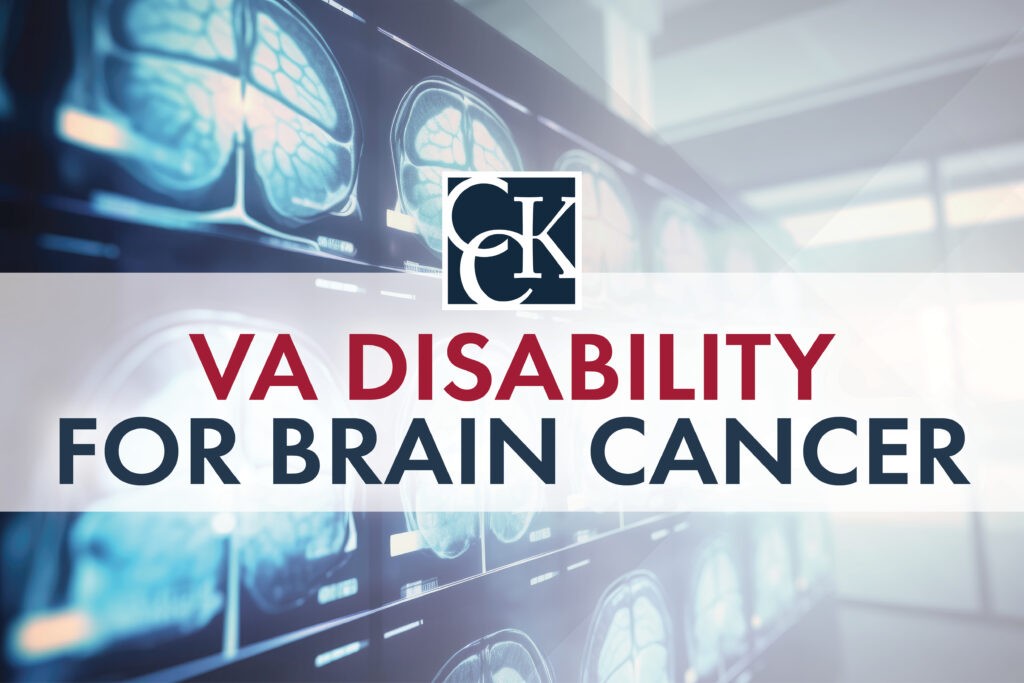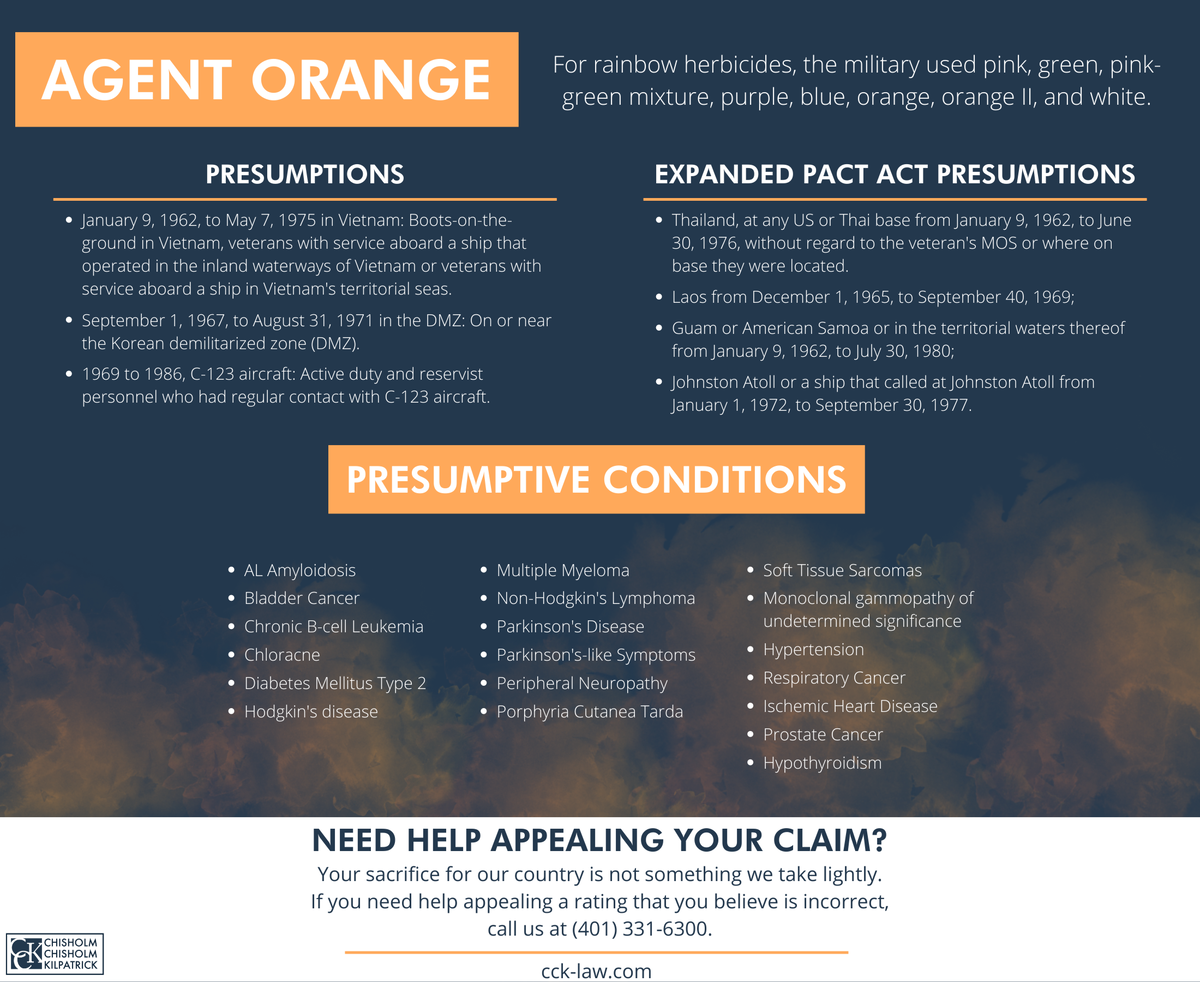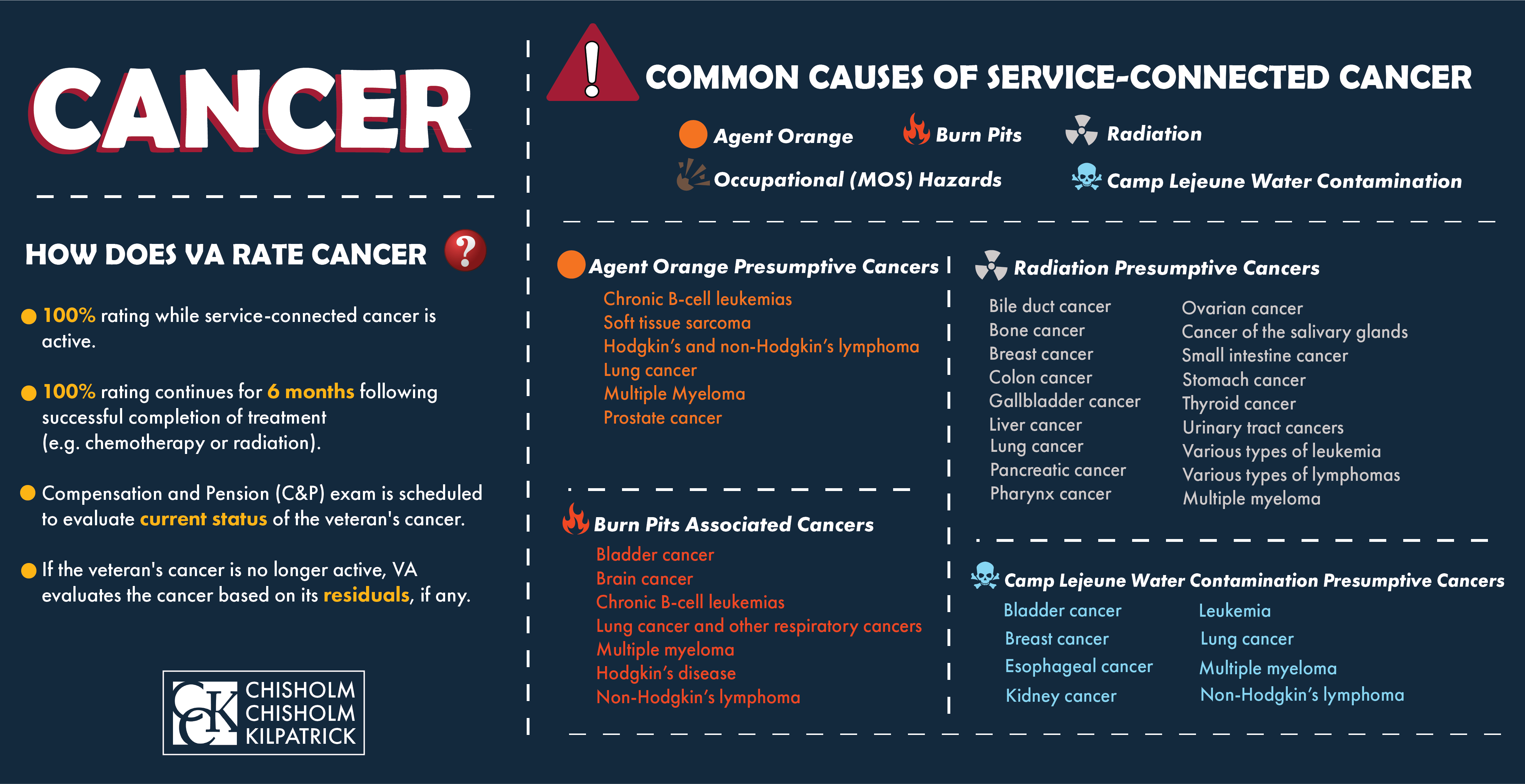VA Disability for Brain Cancer

CCK Law: Our Vital Role in Veterans Law
There are several forms of brain cancer that may be connected to a veteran’s military service. Continue reading to learn more about the ways military service has been linked to brain cancer and how to receive VA disability benefits for your condition.
Understanding Brain Cancer
Sometimes tumors can form on the brain or spinal cord, or the central nervous system. These tumors can be benign or malignant.

If a tumor is benign, it can grow and press on areas of the brain, but benign tumors rarely spread into other tissues. Benign tumors may be recurring.
Malignant tumors can grow rapidly and spread into other tissues and areas of the brain. Like benign tumors, malignant tumors can press on areas of the brain and prevent it from functioning the way it should.
Types of Brain Cancer
Benign Forms of Brain Cancer
- Chordomas — Benign tumors that mostly affect people in their 50s and 60s. These tumors are usually located at the base of the skull or lower end of the spine.
- Craniopharyngiomas — Benign tumors that can be difficult to remove because they are located deep in the brain.
- Gangliocytomas — A type of rare tumor that usually occurs in young adults.
- Glomus jugulare — These tumors are usually benign and are located under the base of the skull, in the top of the jugular vein.
- Meningiomas — The most common form benign intracranial tumor. These tumors originate in the structures that surround the brain and spinal cord called meninges.
- Pineocytomas — Benign lesions which grow from the pineal cells and affect adults most commonly.
- Pituitary adenomas — Pituitary adenomas are usually benign and grow slowly. They are the most common disease to affect the pituitary gland.
- Schwannomas — This is the most common benign brain tumor that affects adults. Schwannomas occur in the nerve cells and can cause serious complications as they can place pressure on the nerves and brain. Sometimes, schwannomas can lead to death.
Malignant Forms of Brain Cancer
- Gliomas — This is the most prevalent form of brain tumor that affects adults. According to the American Association of Neurological Surgeons, this form makes up 78 percent of malignant brain tumors.
- Astrocytomas — Astrocytomas are a form of glioma. Astrocytomas make up about “half of all primary brain and spinal cord tumors.”
- Ependymomas — This form of tumor accounts for 2-3 percent of all brain tumors.
- Glioblastoma multiforme (GBM) — GBM tumors can grow very rapidly and spread to other tissues. They can be made of many different types of cells. Typically, this form of malignant brain cancer affects people between the ages of 50 and 70.
- Medulloblastomas — These tumors are most common in children and form in the cerebellum. They can usually be treated with radiation and chemotherapy.
- Oligodendrogliomas — Tumors that are derived from cells that make myelin.
Other forms of brain tumors fall into other categories, so the above list is not exhaustive.
Diagnosing and Treating for Brain Cancer
Often, certain tests must be done to definitively confirm a diagnosis of brain cancer. Some tests which may be performed to diagnose brain cancer include:
- Computed tomography (CT or CAT scan)
- Magnetic Resonance Imaging (MRI)
- Biopsies
- Magnetic Resonance Spectroscopy (MRS)
- Positron emission tomography (PET scan)
To treat brain cancer, any combination of surgery, radiation, or chemotherapy may be used. Decisions about which treatment is to be used are usually made on a case-by-case basis.
Service Connection for Brain Cancer
To receive VA disability benefits for a brain tumor, veterans need to establish service connection. There are typically three things needed to establish service connection:
- An in-service event, injury, or illness;
- A current diagnosis by a medical professional; and
- A medical nexus, or link, between your in-service event, injury, or illness and your current diagnosis.
One of the most common causes of brain cancer in veterans is exposure to toxins. If a veteran were seeking service connection for brain cancer caused by exposure, they would need to submit a diagnosis of brain cancer and documents indicating their exposure to toxins and supporting evidence regarding the connection between the toxins and brain cancer.
To submit a claim for service connection, veterans can fill out and submit a claim via VA Form 21-526EZ. This form can be submitted online or directly to VA in person.
Toxic Exposure and Brain Tumors
As mentioned above, exposure to certain toxins is one of the most common causes of brain cancer related to military services. Specifically, exposure to agent orange, military burn pits, and ionizing radiation have been linked to brain tumors:
Agent Orange
Agent Orange is a herbicide that was used extensively throughout the Vietnam War Era and later was found to cause many adverse health effects to those who were exposed to it. This is because Agent Orange created the highly toxic contaminant known as 2, 3, 7, 8-Tetrachlorodibenzo-p-dioxin (TCDD) as a byproduct.
One of the conditions that has been linked to Agent Orange is glioblastoma. Glioblastoma is an aggressive form of brain cancer, and the most common type of malignant brain tumor among adults.

In 2017, VA data indicated that more than 500 Vietnam War-era veterans had been diagnosed with glioblastoma at VA health care facilities since 2000. United States Senator and Vietnam veteran John McCain passed away from glioblastoma in 2018, less than a year after being diagnosed.
VA has had a complicated history with granting benefits for glioblastoma related to Agent Orange exposure. Between 2009 and 2017, the Board of Veterans’ Appeals issued more than 100 decisions in cases in which widows have appealed benefit denials related to their husbands’ brain cancer. Of those decisions, about two dozen were granting benefits.
Recently, the Honoring Our PACT Act extended the presumption of herbicide exposure to service members with active military naval, air, or space service who served in:
- The Republic of Vietnam between January 9, 1972 and May 7, 1975;
- Thailand, at any US or Thai base, January 9, 1972 and June 30, 1976;
- Laos between December 1, 1965 an September 30, 1969;
- Cambodia, specifically at Mimot or Krek, Kampong Cham Province, between April 1969 and April 30, 1969;
- Guam or American Samoa or in the territorial waters thereof between January 9, 1962 and July 30, 1980;
- Johnston Atoll island or Johnston Atoll the ship between January 1, 1972 and September 30, 1977.
While the PACT Act did expand the abovementioned service requirements, glioblastoma was not added to the list of conditions eligible for presumptive service connection. This means that veterans need to provide evidence to prove that their Agent Orange exposure caused or contributed to their glioblastoma.
Military Burn Pits
Burn pits are large pits that were used by the U.S. Military to dispose of waste in the post-9/11 era. These pits were used largely throughout Iraq and Afghanistan. Human waste, medical waste, metals, plastics, ammunition, petroleum, and other materials were burned in burn pits.
As the materials burned, toxins were released into the atmosphere. These toxins were carried by the desert wind and, as a result, were breathed in by the many service members who served in the area surrounding the pits.
Glioblastoma has also been linked to exposure to military burn pits. Therefore, the PACT Act added glioblastoma to the list of presumptive conditions linked to burn pit exposure.
Veterans who develop brain cancer after being exposed to burn pits may be eligible for presumptive service connection if their service meets the criteria for “covered veterans.” A covered veteran is one who served:
- On or after August 2, 1990, with active military, naval, air, or space service while assigned to a duty station, including the airspace above:
- Bahrain
- Iraq
- Kuwait
- Oman
- Qatar
- Saudi Arabia
- Somalia
- United States Emirates
- On or after September 11, 2001, with active military, naval, air, or space service while assigned to a duty station, including the airspace above:
- Afghanistan
- Djibouti
- Eqypt
- Jordan
- Lebanon
- Syria
- Yemen
- Uzbekistan
Ionizing Radiation
There are several forms of ionizing radiation including gamma rays, X-rays, and higher ultraviolet parts of the electromagnetic spectrum. Ionizing radiation is extremely harmful to humans. This form of radiation can damage DNA cells because it has enough energy to remove electrons from atoms or molecules. Humans may be exposed to ionizing radiation as it passes through the skin, or it can be inhaled or swallowed.
There are some presumptions of service connection available to veterans who were exposed to ionizing radiation. Specifically, the term “Atomic Veterans” refers to veterans who were likely exposed to radiation or participated in “radiation-risk activity.” Veterans who meet the service criteria specified by VA can be classified as “Atomic Veterans.”
According to the criteria lists, the veteran must have served in:
- Occupation of Hiroshima and Nagasaki, Japan from August 6, 1945 and July 1, 1946, OR
- Prisoners of War (POWs) in Japan during World War II, OR
- Participants in atmospheric nuclear weapons tests, primarily conducted in Nevada and the Pacific Ocean from 1945 to 1962, OR
- Underground nuclear weapons testing in Amchitka Island, Alaska prior to January 1, 1974, OR
- Any of the following gaseous diffusion plants for at least 250 days prior to February 1, 1991:
- Paducah, Kentucky
- Portsmouth, Ohio
- K25 in Oak Ridge, Tennessee, OR
- “Worked as an X-ray technician, in a reactor plant, or in nuclear medicine or radiography,” OR
- “Did tasks like those of a Department of Energy (DoE) employee that makes them a member of the Special Exposure Cohort.”
Additional circumstances in which veterans may have been exposed include:
- The Fukushima nuclear accident in Japan from March 12 to May 11, 2011,
- The U.S. Air Force plutonium clean-up mission in Palomares, Spain,
- Exposure to depleted uranium,
- Exposure to radiation from Long Range Navigation stations (LORAN) from 1942 to 2010,
- McMurdo Station, Antarctica nuclear power plant from 1964 to 1973.
VA does recognize brain cancer, as well as several other conditions, as linked to exposure to ionizing radiation under 38 C.F.R. 3.311. This essentially means that veterans who served in one of the above locations and are diagnosed with brain cancer should be eligible for presumptive service connection.
VA Disability Ratings for Cancer and Residual Effects
If a veteran is service-connected for an active cancer, such as brain cancer, VA should automatically assign a 100 percent disability rating. This rating continues for as long as the cancer is active, and then for another six months following the successful completion of a treatment program, such as chemotherapy; radiation; or surgery.

Six months after the treatment ends, VA will schedule a Compensation & Pension examination to evaluate the current status of the cancer. If the examination shows that the cancer is no longer active and is in remission, VA will evaluate the cancer based on its residuals.
For example, migraines are a common residual symptom of brain cancer. If the brain cancer is no longer active, VA will likely reduce the disability rating for that condition and assign a new rating based on the severity of the veteran’s migraines.
Getting Representation for Brain Cancer VA Disability Claims
Accredited representatives can help veterans navigate the VA claims and appeals process, as well as collect evidence, craft appeals, and submit documentation on behalf of the veteran.
If you require the assistance of an accredited representative, CCK may be able to assist you. Call us today at (800) 544-9144 for a free case evaluation with a member of our team.
About the Author
Share this Post
